The ARM vs x86 Wars Have Begun: In-Depth Power Analysis of Atom, Krait & Cortex A15
by Anand Lal Shimpi on January 4, 2013 7:32 AM EST- Posted in
- Tablets
- Intel
- Samsung
- Arm
- Cortex A15
- Smartphones
- Mobile
- SoCs
SunSpider 0.9.1
The results get more interesting when we look at power consumption during active workloads. We'll start off with SunSpider, a mid-length JavaScript benchmark that we frequently use in our reviews:
At the platform level, Qualcomm's APQ8060 powered Dell XPS 10 falls in between Surface RT and Acer's W510. Active power looks very similar to the Intel powered W510, but performance is appreciably slower so total energy consumed is higher.
Looking at the CPU, the situation changes a bit. Intel's peak power consumption is similar to Tegra 3, while Krait manages to come in appreciably lower. I suspect that missing the L2 cache power island here is lowering Qualcomm's power consumption by 100 - 200mW but overall CPU-only power consumption would still be lower. Once again, at idle Krait seems to have a bit of an advantage as well.
The situation changes once we look at GPU power consumption, with Intel/Imagination having the clear advantage here.

Kraken
Mozilla's Kraken benchmark is a new addition to our js performance suite, and it's a beast. The test runs for much longer than SunSpider, but largely tells a similar story:
At the platform level, Acer's W510 has slightly higher peak power consumption compared to the Dell XPS 10 but it also completes the test quicker, giving it a better overall energy usage profile.
Looking at the CPU cores themselves, Qualcomm holds onto its lead here although once again, I suspect the margin of victory is exaggerated by the fact that we're not taking into account L2 power consumption for Qualcomm. Intel does deliver better performance, which allows the CPU to race to sleep quicker than on APQ8060A.
The comparison to Tegra 3 is not surprising, this is exactly what we've seen play out in our battery life tests as well.
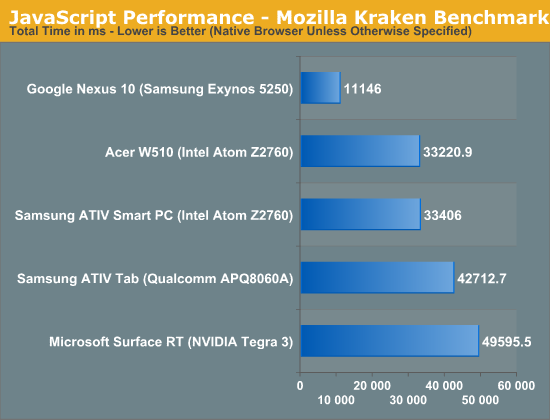
RIABench
RIABench's Focus Tests are on the other end of the spectrum, and take a matter of seconds to complete. What we get in turn is a more granular look at power consumption:
Here the W510 consumes more power at the platform level, but drops to a lower idle state than the XPS 10. Surface RT clearly uses more power than both.
Krait's CPU level (excluding L2 cache) power consumption is once again lower than Atom's, but Atom completes the task quicker. In this case total energy usage is still in Qualcomm's favor. The fact that there's a discrepancy between CPU specific power results and the total platform results are partly due to the missing L2 cache power consumption data from the CPU power chart for Qualcomm, and partly due to differences in the tablets themselves.
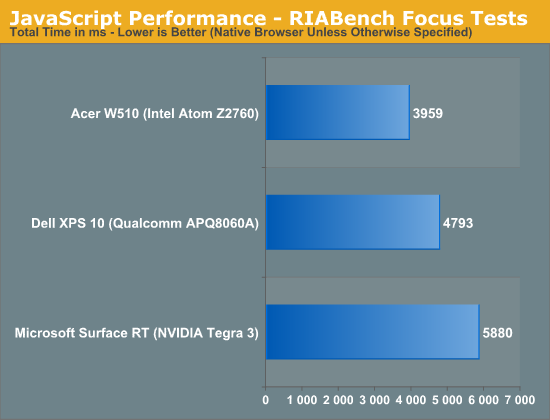


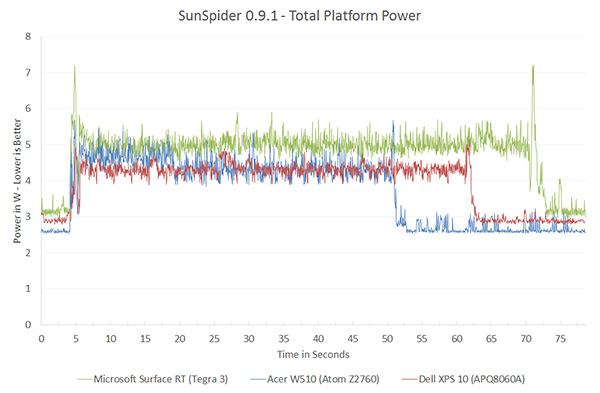


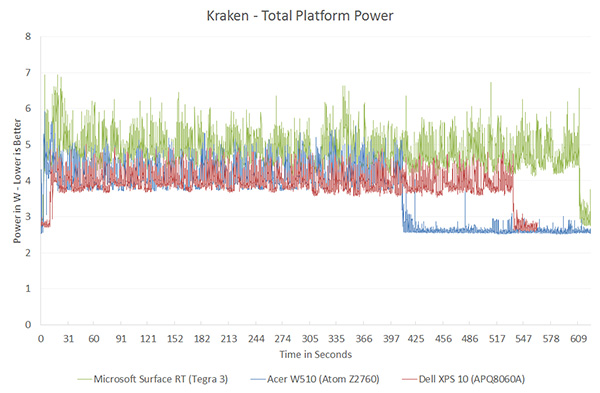
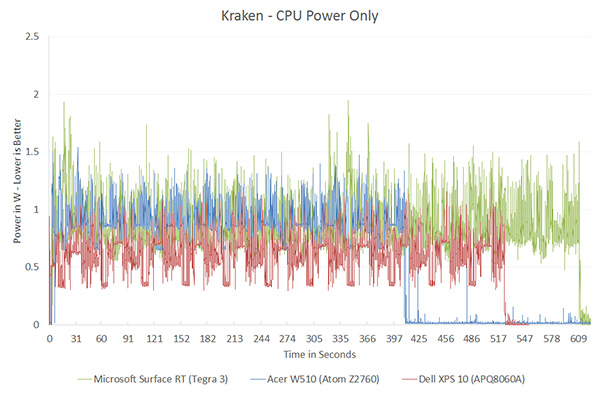
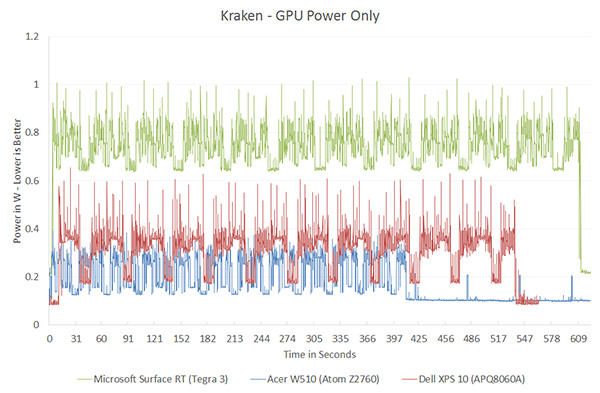
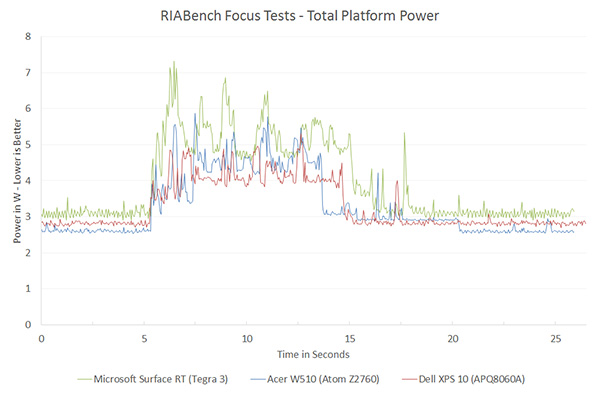
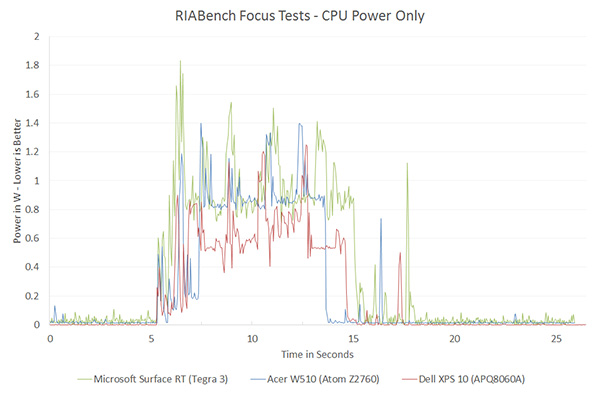
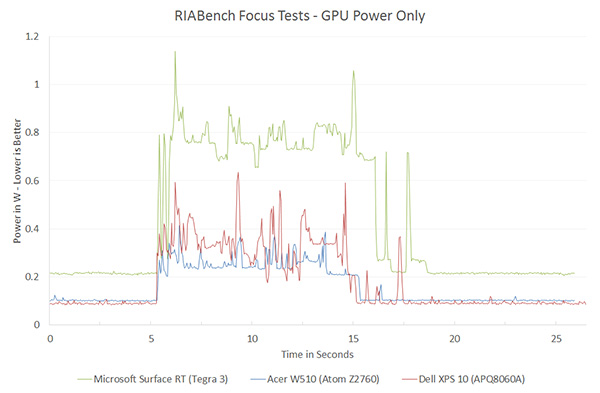








140 Comments
View All Comments
kumar0us - Friday, January 4, 2013 - link
My point was that for a CPU benchmark say Sunspider, the code generated by x86 compilers would be better than ARM compilers.Could better compilers available for x86 platform be a (partial) reason for faster performance of intel. Or compilers for ARM platform are mature and fast enough that this angle could be discarded?
iwod - Friday, January 4, 2013 - link
Yes, not just compiler but general optimization in software on x86. Which is giving some advantage on Intel's side. However with the recent surge of ARM platform and software running on it my ( wild ) guess is that this is less then 5% in the best case scenario. And it is only the worst case, or individual cases like SunSpider not running fully well.jwcalla - Friday, January 4, 2013 - link
Yes. And it was a breath of fresh air to see Anand mention that in the article.Look at, e.g., the difference in SunSpider benchmarks between the iPad and Nexus 10. Completely different compilers and completely different software. As the SunSpider website indicates, the benchmark is designed to compare browsers on the same system, not across different systems.
monstercameron - Friday, January 4, 2013 - link
it would be interesting to throw an amd system into the benchmarking, maybe the current z-01 or the upcoming z-60...silverblue - Friday, January 4, 2013 - link
AMD has thrown a hefty GPU on die, which, coupled with the 40nm process, isn't going to help with power consumption whatsoever. The FCH is also separate as opposed to being on-die, and AMD tablets seem to be thicker than the competition.AMD really needs Jaguar and its derivatives and now. A dual core model with a simple 40-shader GPU might be a competitive part, though I'm always hearing about the top-end models which really aren't aimed at this market. Perhaps AMD will use some common sense and go for small, volume parts over the larger, higher performance offerings, and actually get themselves into this market.
BenSkywalker - Friday, January 4, 2013 - link
There is an AMD design in their, Qualcomm's part.A D R E N O
R A D E O N
Not a coincidence, Qualcomm bought AMD's ultra portable division off from them for $65 million a few years back.
Anand- If this is supposed to be a CPU comparison, why go overboard with the terrible browser benchmarks? Based on numbers you have provided, Tegra 3 as a generic example is 100% faster under Android then WinRT depending on the bench you are running. If this was an article about how the OSs handle power tasks I would say that is reasonable, but given that you are presenting this as a processor architecture article I would think that you would want to use the OS that works best with each platform.
powerarmour - Friday, January 4, 2013 - link
Agreed, those browser benchmarks seem a pretty poor way to test general CPU performance, in fact browser benchmarks in general just test how optimized a particular browser is on a particular OS mainly.In fact I can beat most of those results with a lowly dual-A9 Galaxy Nexus smartphone running Android 4.2.1!
Pino - Friday, January 4, 2013 - link
I remember AMD having a dual core APU (Ontario) with a 9W TDP, on a 40nm process, back in 2010.They should invest on a SOC
kyuu - Friday, January 4, 2013 - link
That's what Temash is going to be. They just need to get it on the market and into products sooner rather than later.jemima puddle-duck - Friday, January 4, 2013 - link
Impressive though all this engineering is, in the real world what is the unique selling point for this? Normal people (not solipsistic geeks) don't care what's inside their phone, and the promise of their new phone being slighty faster than another phone is irrelevant. And for manufacturers, why ditch decades of ARM knowledge to lock yourself into one supplier. The only differentiator is cost, and I don't see Intel undercutting ARM any time soon.The only metric that matters is whether normal human beings get any value from it. This just seems like (indirect) marketing by Intel for a chip that has no raison d'etre. I'm hearing lots of "What" here, but no "Why". This is the analysis I'm interested in.
All that said, great article :)